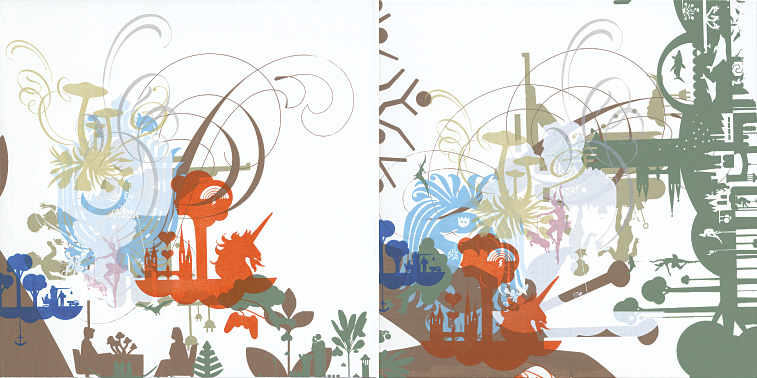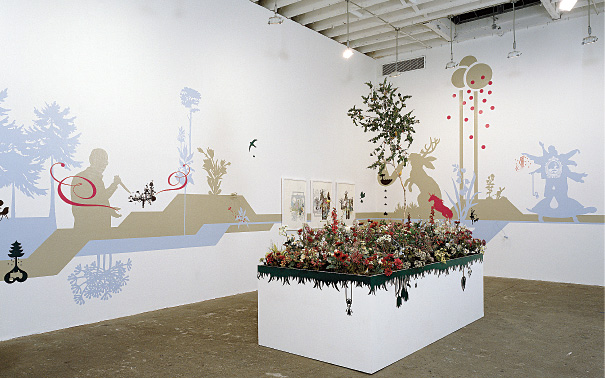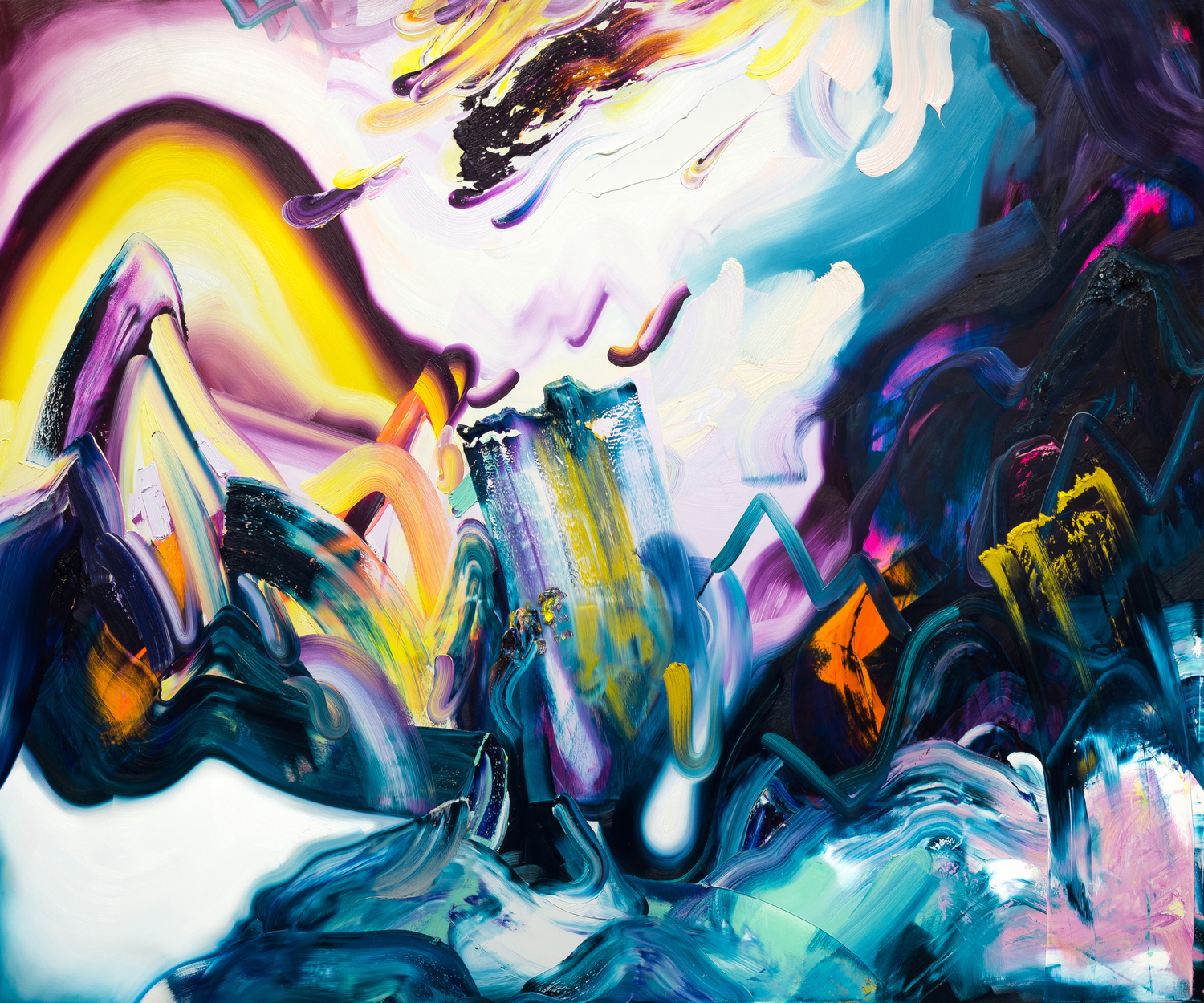By Randy Gladman
A small TV in a corner of the gallery projects a video of your worst nightmare. Office hell: A shallow space with white walls and whiter lighting, a nondescript table, and a generic clock, hung low on the wall so it appears in the tight camera angle view. The time is apparently twenty-one minutes past the hour and a skinny dude in a white business shirt sits at the table in obvious discomfort. He looks bad. Hurting bad. As he rubs his hand across his clean-shaven head, you notice that there is a six-pack of beers (Pabst Blue Ribbon) on the table and a shot glass in his hand. With the passing of every minute, he downs a shot of beer and then pours himself another. In a perverse funk, this character attempts to drink a shot of beer every minute for an hour. The first highlight of the video occurs just after the 23rd shot when the drinker pukes all over the table. Without cleaning it up, he pours himself another ounce and waits for the next minute to arrive. He pukes two more times before the hour concludes.
The actor/guinea pig is Ryan McGinness. He is also the producer, director, writer, and cameraman. You wouldn’t know it from this artist video, but McGinness is on the verge of busting the eggshell of the art world wide open and letting the rich, goopy yolk drip down to a democratic pool from which we can all feed. Relying heavily on a dose of influence from his Pop art predecessors but injecting it with sensibilities based in hip-hop hype, skater style and graffiti guerilla warfare, McGinness has pioneered a new territory in the realm of high art. He inhabits the thin layer of skin that separates design from art, armed with an aesthetic philosophy now known as Flatnessisgod, a sense of worship in the importance of surface and the pervasive coolness present in all forms of contemporary pop culture.
McGinness extracts ideas, shared experiences and materials from pop culture and elevates them in an attempt to delineate what brings us together as consumers and producers. In the 60-minute video discussed above, Hour of Power (2001), he uses beer and a college tradition to comment on corporate exploitation of the workforce and the role of ritualized substance abuse. In Saving Ryan’s Privates he glues 10,000 plastic soldiers onto a board resulting in a stunning sculptural painting. The title is an obvious pun on Spielberg’s “Wagnerian orgy of violence” Saving Private Ryan and the work satires American-style military edutainment and Hollywood-inspired lemming-like mentality.
Although the artist often uses traditional mediums such as paint on canvas, he continues to exploit less precious materials culled from daily existence. The intent is to democratize art in order to make it more accessible. Like a modern Robin Hood, he perverts expected capitalist infrastructures with a cunning slight of hand. In 1999, McGinness first caught art press attention by screwing with gift shops in major New York City museums. He fabricated postcards identical to those sold by the Whitney Museum of American Art and the Museum of Modern Art, complete with the same fonts, bar codes, and logos of the institutions, but he replaced the images of, say, van Gogh’s Starry Night with depictions of his own art works. After infiltrating the postcard racks in the gift shops with his own cards, he arranged for friends and sympathizers to attempt to purchase the moles. Although the postcards remained as the residue of the ‘installation / performance’, the real artistic object of the work was the commotion it caused at the check out counter of the shop when the computerized cash registers didn’t recognize the product.
Appropriating elements from film, television, music, art history, and urban collective consciousness, McGinness (29 years old) feeds omnivorously on the detritus of pop culture, recycling, transforming and condensing the iconography and iconology of a generation. In Sign Series: 80s Sitcoms, the lyrics of sitcom theme songs are soberly engraved in white text on red plastic signs. Subtly and unexpectedly hung in random public areas, their messages are meant to awaken passersby with misplaced and nostalgic phrases: “Makin’ your way / in the world today / takes everything you’ve got.” Small and cheaply made, McGinness hangs the pieces loosely in order to encourage people to steal them and take them home. A similar series called Sign Series: Pick Up Lines offers the kind of sleaze ball lines you might hear at a dive bar in the meat packing district: “As long as I have a face, you have a place to sit”. Perhaps the lowest forms of poetry and theatre, the callow pick-up line and the shallow television sitcom jingle are promoted into the hallowed space of the art gallery.
In 2000, McGinness ventured into the skate world with a series of hand-painted skateboards. Although painting on wood panels has been a tradition in art for centuries, the pill-shaped oval of the skateboard deck afforded a new format, and McGinness was attracted to the medium for its fresh formal qualities and its value as a symbol of youth culture. The first decks he hand painted with imagery familiar from his canvas works, often using readily identifiable iconography extracted from the signs in public spaces and clip art programs. But because these decks were hand-painted, they were necessarily expensive ($400) and tended to remain wheel-less paintings meant more for a gallery wall than for a halfpipe.
Around the time McGinness was first creating these paintings, he was contacted by James Jebbia, owner of Supreme and a partner of the Stussy brand of streetwear fashion. Jebbia is a fan of McGinness’s 1999 book of graphic design, Flatnessisgod, and contacted the artist through their common friend, KAWS, also an artist who exploits consumer culture-based imagery. The result of their meeting was a series of skateboards designed by McGinness and manufactured by Supreme.
As a kid, McGinness skateboarded and built ramps, halfpipes and launch ramps. “I was never really very good,” explains the artist, “but I was enthusiastic about the graphics and styles that defined what was cool.” Recognizing the improbability of ever being a skate star himself, McGinness instead committed himself to creating the signs and signifiers that identified the group to which he wanted to belong. Now years later, he finds himself inserted into the skate tradition of great companies sponsoring spectacular riders. The “Ryan McGinness for Supreme” decks hit Supreme’s New York City and Tokyo shops in September, 2000. Referring to his profession as a graphic designer instead of as a rider, the boards are tricked out Pantone color formula guides, an essential tool for all graphics professionals. When they were exhibited at Joseph Silvestro Gallery in the art-hip Brooklyn village of Williamsburg, a sample of each version was bolted together and fan-displayed like a giant Pantone booklet. Five different versions of the board were made, each in editions of 500, and almost all sold out at $55 before the end of the year, mostly in Japan. The few leftovers are now selling for $110.
2000 ended with McGinness’s solo show at Houston, an art gallery in Seattle with a mandate focusing on young, urban art. The exhibition, a symphony of variations on a skateboard theme, was titled Shtick referring to both the slang term for a skateboard (stick) and the gimmick-like approach of much of McGinness’s work. Alongside skateboard paintings and sculptural ramps made from cardboard and glue was hung a series of ‘grip tape’ paintings. Formally referencing twentieth-century abstract paintings by artists such as Ellesworth Kelley in their flat fields of color and subtly curving lines, these pieces are amplified by their 1980s nostalgia-inducing fluorescent hues. The curves they depict evoke those of transition ramps, so familiar to McGinness from visits to skate parks during his childhood. Their surfaces are not painted but rather carefully cut and applied with the grip tape. McGinness located a manufacturer of the material in California who had rolls of highlighter-colored grip tape left over from the heady Miami Vice days of the late 1980s. Fitting perfectly into his artistic practice and methodology, these works offer flat imagery reduced from pop culture and reuse common materials in untraditional manners.
McGinness never steps onto a skateboard anymore. But his graphic style has helped shape the current hip aesthetics of youth culture among urban factions sympathetic to the skate world. The first two editions of his influential 1999 visual design manifesto Flatnessisgod have sold out and publishers are currently considering a third press. Two artist books have been published, Pieceofmind (2001) and Luxurygood (2000), each in limited editions of 1000 signed copies. Joseph Silvestro Gallery produced an early retrospective catalogue of Ryan’s work to accompany the exhibition at that gallery last spring. The artist is currently preparing for a final burst of productivity to finish Beck, the second work in a series of visual biography books that began with Carrot Top (2001). With a hectic exhibition schedule, excellent distribution channels for his book works, and a near obsessive-compulsive work ethic, McGinness is disseminating his design philosophy with the pervasiveness and speed of a computer virus.
Gorging on the icons of mass communication, McGinness digests the discarded chips of visual pop culture and regurgitates a rehydrated paste of common experience. Whether it cameos in his videos every few shots, or gets widely dispersed around Manhattan by randomly applied stickers carrying his sarcastic criticisms of art itself, his work forces a second consideration of our consumerist habits and afflictions. By resuscitating the leftovers created by the American culture machine and marrying it to a keen concept of art and value, McGinness has stepped into a space where highbrow art meets popular entertainment and enjoyment. “I strive to be a part of culture,” he explains, “not just the art world.”
By Randy Gladman. Originally published in Strength: Skateboard Culture Magazine, January/February 2002.



